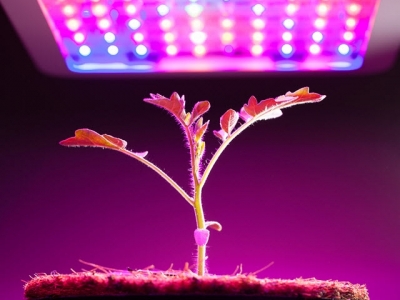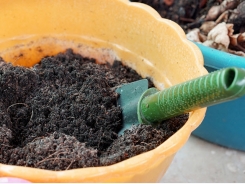Grow Lights for Indoor Plants and Indoor Gardening: An Overview

Large, LED arrays like this aren't your only options when it comes to grow lights for indoor gardening and plants.
Photo: By nikkytok / Shutterstock.com
Indoor growing offers many advantages. The biggest benefits are the most obvious: garden pests can’t get at your plants, and you have total control over the weather.
Yet unless you’re lucky enough to have a solarium or greenhouse attached to your home, providing sufficient light to your plants will likely be an obstacle (shade-tolerant houseplants excepted). South-facing windows may provide enough light for a tray or two of seedlings, but if you want to grow vegetables, or any other sun-loving plants, to maturity, you’re going to need grow lights.
The indoor lighting found in most homes does little to support photosynthesis. Traditional incandescent bulbs do not have the proper spectrum of light, or intensity, to supplant the sun. Household fluorescent bulbs can make effective grow lights, but only if they are placed in within a few inches of the foliage and left on for 16 hours per day not ideal.
Warm vs Cool: Understanding Color Spectrum in Grow Lights
When shopping for grow lights, you’ll notice they are labeled with numbers like 2700K or 4000K. This refers to their relative warmth or coolness on the color spectrum the higher the number, the cooler the light. Foliage growth is generally best around 6500K, though many plants need a period of warmer light, around 3000K, in order to produce flowers, and thus fruit.
In other words, if your goal is to simply produce seedlings, leafy green vegetables, or root crops, you only need higher spectrum bulbs. If you want to grow flowers, marijuana, or any fruiting plant (cucumbers, tomatoes, peppers, lemons, etc.), you’ll also require low spectrum bulbs. You can some types of bulbs are available in full-spectrum form, however, simplifying things.
Types of Grow Lights
There are three main types of grow lights.

Full-spectrum fluorescent lights either of the tube or standard CFL variety are a great choice when starting seeds indoors. PHOTO: By Falcona / Shutterstock.com
Fluorescent Grow Lights
The standard fluorescent bulb, commonly denoted T12, makes a decent grow light for houseplants, starting seeds, supplementing the natural light of a window, and other situations where lighting needs are modest. They are fairly weak in light intensity, however, and must be placed within a few inches of the foliage to have much of an effect.
T5 fluorescent bulbs, which are narrower in diameter than T12s (but still widely available wherever lightbulbs are sold), have a much higher light intensity, making them suitable as a sole light source for sun-loving plants. Compact fluorescent bulbs (CFLs) are an option for small spaces, or if you don’t like the look of long rectangular fluorescent light fixtures CFLs will screw into an ordinary incandescent light fixture.
Look for specialized full-spectrum fluorescent grow bulbs (like this T5 option, or this CFL option, which fits into a standard socket) to provide the right balance of light for flowering plants.
LED Grow Lights
While they are considerably more expensive than fluorescent bulbs, LEDs use half the electricity and last five times longer, more than paying for themselves in the long run. The average LED bulb from the hardware store is not designed for plant growth, however you need special LED grow bulbs, a relatively new technology that is increasingly available from horticultural suppliers.
LED grow bulbs are capable of much greater light intensity than fluorescent bulbs and are available in full-spectrum form. An easy rule of thumb: Fluorescent bulbs are often used when growing just a handful of plants; LEDs are preferable for larger quantities since you can achieve higher light intensity per square foot. Another advantage of LEDs? They produce very little heat compared to other bulbs an issue that can become problematic when you have a lot of lights in a small space.
HID Grow Lights
Before the advent of LED grow lights, HID (high-intensity discharge) lights were the main option for large indoor plantings. They are extremely powerful, but are expensive to purchase, consume electricity inefficiently, require special light fixtures, and give off a lot of heat. All that said, they are very effective and are still widely used. If you want to grow large plants like tomatoes or lemon bushes, HIDs are good bet because the light penetrates farther into the foliage than with other bulbs.
There are two types of HID bulbs. High-pressure sodium (HPS) bulbs are best for flowering (low spectrum), while MH (metal halide) bulbs are required to support vegetative growth (high spectrum); the two types are often used in conjunction. Unfortunately, each type requires its own fixture.
How to Install Grow Lights
Installation requirements vary drastically depending on the scope of your indoor garden and the type of bulb used. But here are a few basic steps to get you started.
Figure out how many bulbs you need.
Most edible plants require at least 30 watts per square foot, but fruiting species (like tomatoes) generally won’t produce abundant high-quality crops without 40 to 50 watts per square foot. Wattage is always indicated on the bulb package. Simply multiply the square footage of your growing area by the number of watts you plan to provide (between 30 and 50); then divide by the number of watts supplied by the bulbs you plan to use.
Devise a light rack.
You’ll need a way to support the bulbs over the plants at the proper height. And unless you’re growing something that will remain at more or less the same height throughout its lifespan, you’ll also need a way to raise the light rack as the plants grow. This is usually accomplished through some sort of pulley system or by hanging the light fixtures with metal chain that way you can easily adjust the height by changing the link the light fixture is home from. Grow light racks are also available for purchase online.
Add the necessary accoutrements.
It is generally wise to plug your lights into a timer to ensure they get the proper amount of light, and that they get it at the same time each day. Fancy ones are available for indoor growing, though a standard lamp timer also works. If your lights bring the temperature above 80 degrees or so in your growing area, install a ventilation system to prevent heat stress. Aficionados make use of reflectors and all sorts of other grow light accessories to achieve optimum results.
How Long Should I Leave Grow Lights On?
Plants grown indoors require more hours of light than those grown outdoors. 14 to 18 hours of light per day is recommended for most edible species when grown under artificial lighting. Don’t be tempted to leave the lights on 24-7, however—at least six hours of darkness each day is essential to plant health.
As the plants grow, raise the light fixture accordingly to maintain the optimal distance, which varies depending on the type of bulb used and its wattage (the higher the wattage, the farther away the bulb can be). Here are the basic parameters:
Fluorescent Grow Light: 3 to 12 inches
LED Grow Light :12 to 24 inches
HID Grow Light: 24 to 60 inches
Happy planting!
Có thể bạn quan tâm
Phần mềm

Phối trộn thức ăn chăn nuôi

Pha dung dịch thủy canh

Định mức cho tôm ăn

Phối trộn phân bón NPK

Xác định tỷ lệ tôm sống

Chuyển đổi đơn vị phân bón

Xác định công suất sục khí

Chuyển đổi đơn vị tôm

Tính diện tích nhà kính

Tính thể tích ao hồ



 Tunnel farming with cucumbers methods for success
Tunnel farming with cucumbers methods for success  Cucumbers save the day
Cucumbers save the day